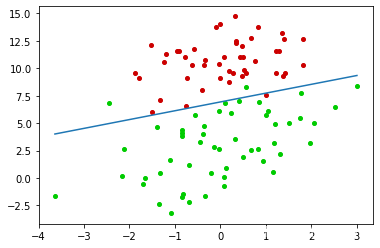本算法算是本人在学习机器学习过程中的入门算法之一。
该算法实现了纯手工打造,每一行代码都包含原创作者的心血,是算法中的劳斯莱斯,向该算法的原创作者致敬!
参考地址:点击打开
计算较为繁琐,需要用到sigmoid函数和梯度下降算法,算法的步骤主要如下:
- 二项分布概率公式
- 最大似然估计法
- 求导数
- 梯度下降算法和优化

代码:
import numpy as np
import matplotlib.pyplot as plt
def sigmoid(z):
return 1.0/(1+np.exp(-z))
# datas NxD
# labs Nx1
# w Dx1
def weight_update(datas,labs,w,alpha=0.01):
z = np.dot(datas,w) # Nx1
h = sigmoid(z) # Nx1
Error = labs-h # Nx1
w = w + alpha*np.dot(datas.T,Error)
return w
# 随机梯度下降
def train_LR_batch(datas,labs,batchsize=80,n_epoch=2,alpha=0.005):
print("epoch:%d,alpha:%.8f batchsize:%d"%(n_epoch,alpha,batchsize))
N,D = np.shape(datas)
# weight 初始化
w = np.ones([D,1]) # Dx1
N_batch = N//batchsize #取整数
print("n:%d d:%d batchsize:%d"%(N,D,batchsize))
for i in range(n_epoch):
# 数据打乱
rand_index = np.random.permutation(N).tolist()
# 每个batch 更新一下weight
for j in range(N_batch):
print("i:%d j:%d N_batch:%d\r\n"%(i,j,N_batch))
# alpha = 4.0/(i+j+1) +0.01
index = rand_index[j*batchsize:(j+1)*batchsize]
batch_datas = datas[index]
batch_labs = labs[index]
w=weight_update(batch_datas,batch_labs,w,alpha)
error = test_accuracy(datas,labs,w)
print("epoch %d error %.2f%%"%(i,error*100))
return w
def train_LR(datas,labs,n_epoch=2,alpha=0.005):
N,D = np.shape(datas)
w = np.ones([D,1]) # Dx1
# 进行n_epoch轮迭代
for i in range(n_epoch):
w = weight_update(datas,labs,w,alpha)
error_rate=test_accuracy(datas,labs,w)
print("epoch %d error %.3f%%"%(i,error_rate*100))
return w
def test_accuracy(datas,labs,w):
N,D = np.shape(datas)
z = np.dot(datas,w) # Nx1
h = sigmoid(z) # Nx1
lab_det = (h>0.5).astype(np.float)
error_rate=np.sum(np.abs(labs-lab_det))/N
return error_rate
def draw_desion_line(datas,labs,w,name="0.jpg"):
dic_colors={
0:(.8,0,0),1:(0,.8,0)}
# 画数据点
for i in range(2):
index = np.where(labs==i)[0]
sub_datas = datas[index]
plt.scatter(sub_datas[:,1],sub_datas[:,2],s=16.,color=dic_colors[i])
# 画判决线
min_x = np.min(datas[:,1])
max_x = np.max(datas[:,1])
w = w[:,0]
x = np.arange(min_x,max_x,0.01)
y = -(x*w[1]+w[0])/w[2]
plt.plot(x,y)
plt.savefig(name)
def load_dataset(file):
with open(file,"r",encoding="utf-8") as f:
lines = f.read().splitlines()
# 取 lab 维度为 N x 1
labs = [line.split("\t")[-1] for line in lines]
labs = np.array(labs).astype(np.float32)
labs= np.expand_dims(labs,axis=-1) # Nx1
# 取数据 增加 一维全是1的特征
datas = [line.split("\t")[:-1] for line in lines]
datas = np.array(datas).astype(np.float32)
N,D = np.shape(datas)
# 增加一个维度
datas = np.c_[np.ones([N,1]),datas]
return datas,labs
if __name__ == "__main__":
''' 实验1 基础测试数据'''
# 加载数据
file = "testset.txt"
datas,labs = load_dataset(file)
#weights = train_LR(datas,labs,alpha=0.001,n_epoch=800)
weights = train_LR_batch(datas,labs,batchsize=80,alpha=0.001,n_epoch=800)
print(weights)
draw_desion_line(datas,labs,weights,name="test_1.jpg")
训练需要的数据集testset.txt文件:
-0.017612 14.053064 0
-1.395634 4.662541 1
-0.752157 6.538620 0
-1.322371 7.152853 0
0.423363 11.054677 0
0.406704 7.067335 1
0.667394 12.741452 0
-2.460150 6.866805 1
0.569411 9.548755 0
-0.026632 10.427743 0
0.850433 6.920334 1
1.347183 13.175500 0
1.176813 3.167020 1
-1.781871 9.097953 0
-0.566606 5.749003 1
0.931635 1.589505 1
-0.024205 6.151823 1
-0.036453 2.690988 1
-0.196949 0.444165 1
1.014459 5.754399 1
1.985298 3.230619 1
-1.693453 -0.557540 1
-0.576525 11.778922 0
-0.346811 -1.678730 1
-2.124484 2.672471 1
1.217916 9.597015 0
-0.733928 9.098687 0
-3.642001 -1.618087 1
0.315985 3.523953 1
1.416614 9.619232 0
-0.386323 3.989286 1
0.556921 8.294984 1
1.224863 11.587360 0
-1.347803 -2.406051 1
1.196604 4.951851 1
0.275221 9.543647 0
0.470575 9.332488 0
-1.889567 9.542662 0
-1.527893 12.150579 0
-1.185247 11.309318 0
-0.445678 3.297303 1
1.042222 6.105155 1
-0.618787 10.320986 0
1.152083 0.548467 1
0.828534 2.676045 1
-1.237728 10.549033 0
-0.683565 -2.166125 1
0.229456 5.921938 1
-0.959885 11.555336 0
0.492911 10.993324 0
0.184992 8.721488 0
-0.355715 10.325976 0
-0.397822 8.058397 0
0.824839 13.730343 0
1.507278 5.027866 1
0.099671 6.835839 1
-0.344008 10.717485 0
1.785928 7.718645 1
-0.918801 11.560217 0
-0.364009 4.747300 1
-0.841722 4.119083 1
0.490426 1.960539 1
-0.007194 9.075792 0
0.356107 12.447863 0
0.342578 12.281162 0
-0.810823 -1.466018 1
2.530777 6.476801 1
1.296683 11.607559 0
0.475487 12.040035 0
-0.783277 11.009725 0
0.074798 11.023650 0
-1.337472 0.468339 1
-0.102781 13.763651 0
-0.147324 2.874846 1
0.518389 9.887035 0
1.015399 7.571882 0
-1.658086 -0.027255 1
1.319944 2.171228 1
2.056216 5.019981 1
-0.851633 4.375691 1
-1.510047 6.061992 0
-1.076637 -3.181888 1
1.821096 10.283990 0
3.010150 8.401766 1
-1.099458 1.688274 1
-0.834872 -1.733869 1
-0.846637 3.849075 1
1.400102 12.628781 0
1.752842 5.468166 1
0.078557 0.059736 1
0.089392 -0.715300 1
1.825662 12.693808 0
0.197445 9.744638 0
0.126117 0.922311 1
-0.679797 1.220530 1
0.677983 2.556666 1
0.761349 10.693862 0
-2.168791 0.143632 1
1.388610 9.341997 0
0.317029 14.739025 0
anaconda jupyter notebook中的运行结果截图:
